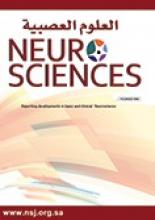Abstract
OBJECTIVE: To investigate whether the tetracyclic antidepressant mirtazapine has a pain-suppressing effect in healthy animals.
METHODS: In the first step, Swiss albino female mice weighing 25-35 g were used. Eight groups each containing 8 mice were established as follows:- Control (saline), mirtazapine 5 mg/kg, 10 mg/kg, and 20 mg/kg, mirtazapine 10mg/kg and its combinations L-Nitro-L-Arginine Methyl Ester (L-NAME) 100 mg/kg, L-Arginine 100 mg/kg, naloxone 1 mg/kg, and cyproheptadine 50 ug/kg. This study was performed in the Department of Pharmacology, Faculty of Medicine, Eskisehir Osmangazi University, Eskisehir, Turkey during March, April, and May 2009. One hour after the drugs were given intraperitoneally, hot plate, tail clip, tail flick, and writhing tests were used for evaluating antinociceptive effects. In the second step, the brain hippocampus of Sprague Dawley type male rats weighing 250+/-20 g were isolated and 0.6 um hippocampus slices were obtained. In vitro groups were established as control, mirtazapine 3x10-3M, 4x10-3M, 5x10-3M, mirtazapine 4x10-3M and its combinations L-NAME, L-Arginine, naloxone, and cyproheptadine 4x10-3M.
RESULTS: Mirtazapine did not show central spinal analgesic activity, but had significant peripheral and biphasic central analgesic effects at the supraspinal level. In addition, there were no significant differences between the different groups in nitric oxide synthase levels on the brain slices.
CONCLUSION: The nitrergic pathway does not have an effect on the central antinociceptive activity of mirtazapine, while opiatergic and serotonergic pathways have a significant role.
- Copyright: © Neurosciences
Neurosciences is an Open Access journal and articles published are distributed under the terms of the Creative Commons Attribution-NonCommercial License (CC BY-NC). Readers may copy, distribute, and display the work for non-commercial purposes with the proper citation of the original work.






